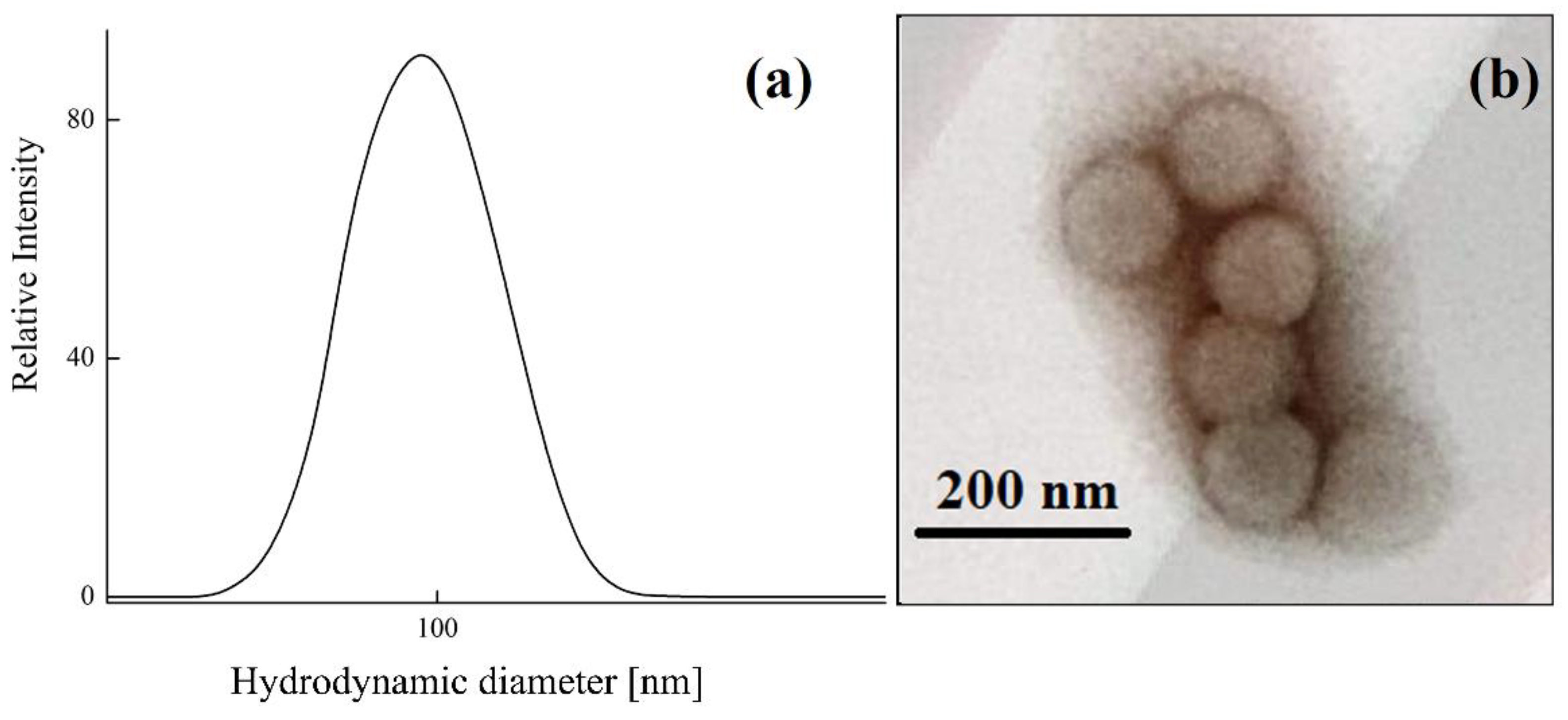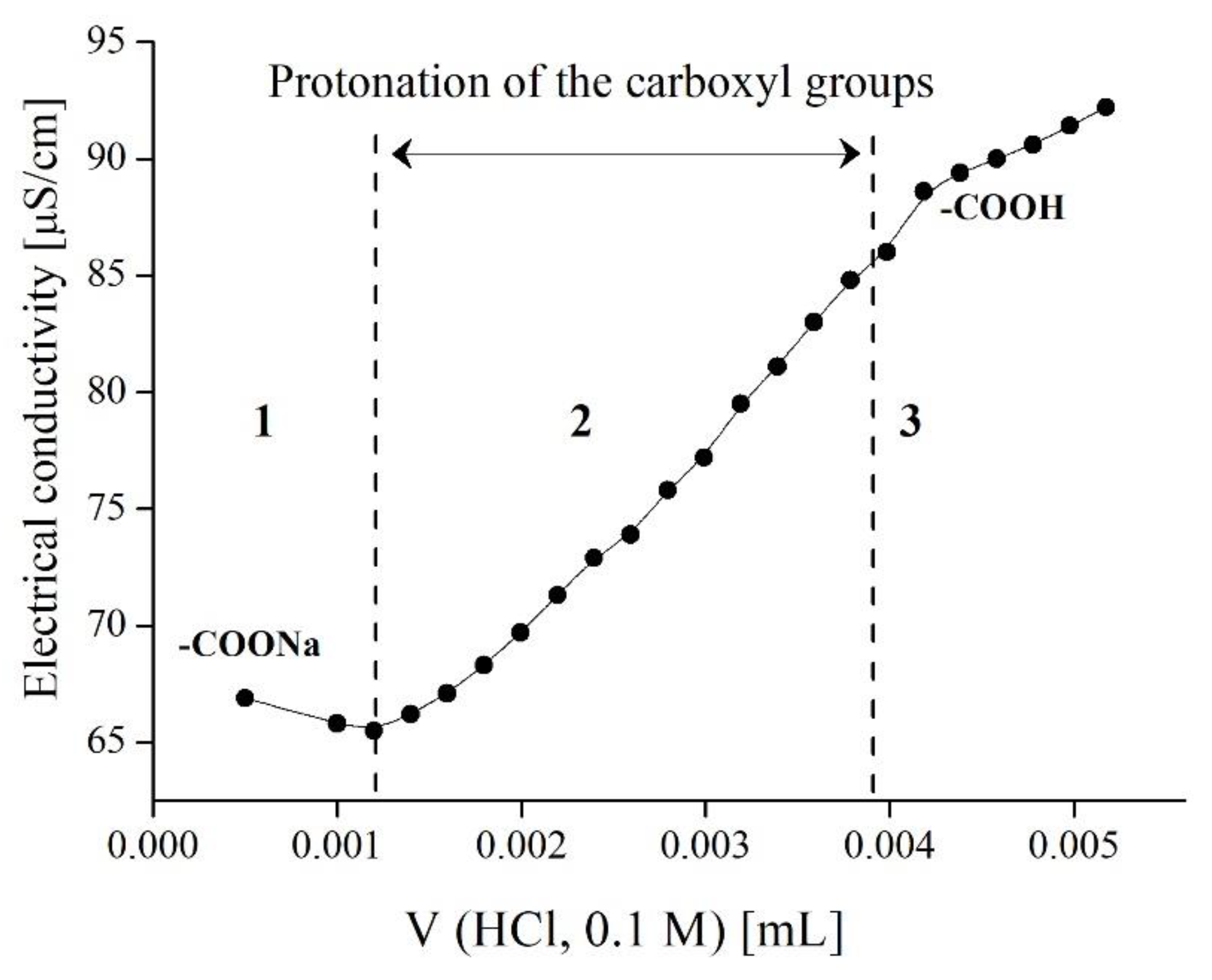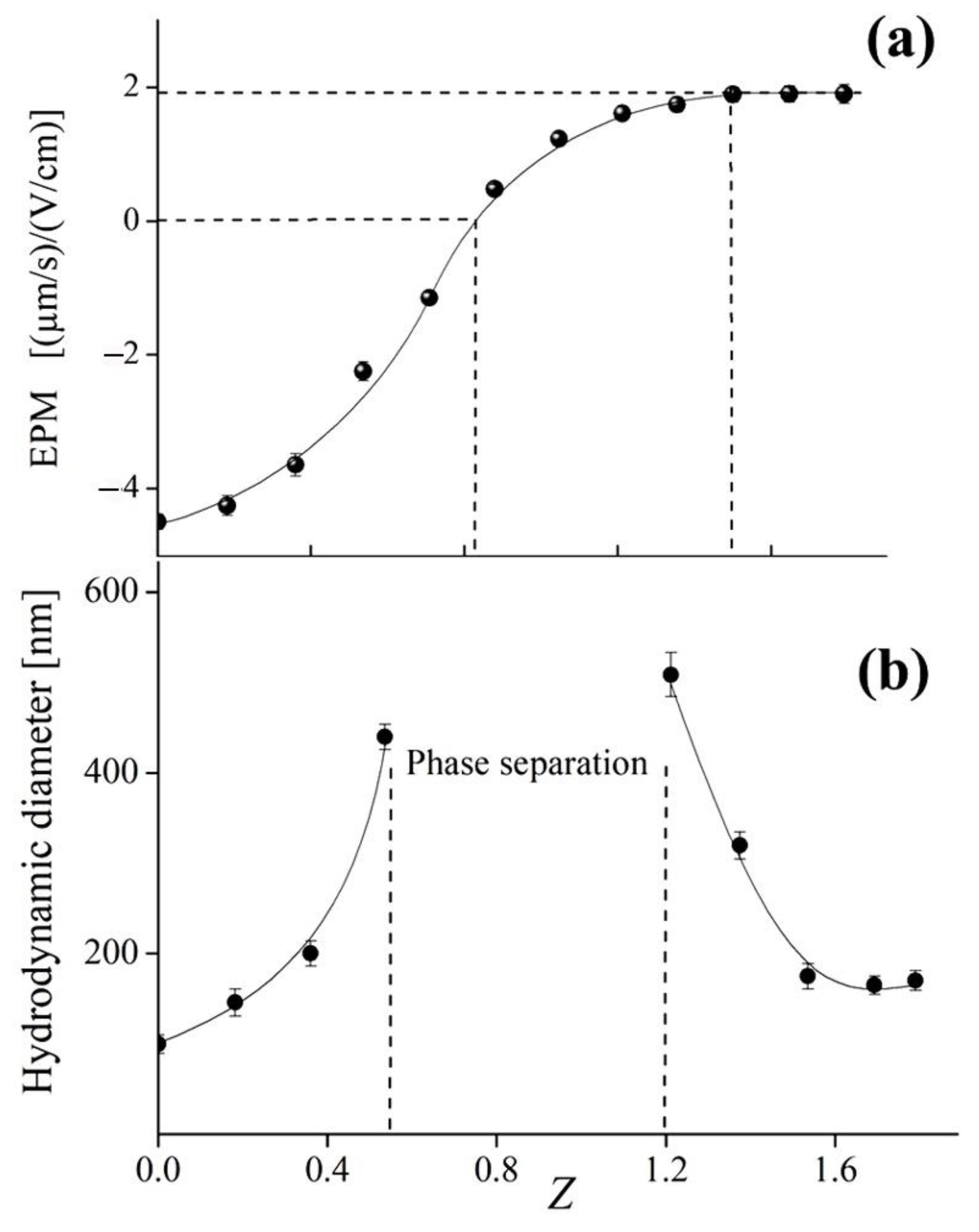Biocidal Coatings from Complexes of Carboxylated Latex Particles and a Linear Cationic Polymer
Abstract
:1. Introduction
2. Materials and Methods
2.1. Materials
2.2. Methods
3. Results and Discussion
3.1. Colloid-Chemical Properties of Latex
3.2. Formation of the Complexes between cBSL Microspheres and PDADMAC
3.3. Investigation of Antimicrobial Properties of Polymer–Latex Formulations in Aqueous Solution
3.4. Antimicrobial Activity of cBSL and W = 12 cBSL/PDADMAC Films
3.5. Influence of Initial Titer of Deposited Microorganisms on the Survival of the Gram-Negative Bacteria P. aeruginosa
3.6. Biocidal Properties of W = 12 cBSL/PDADMAC Films after Washing with Water
4. Conclusions
Author Contributions
Funding
Institutional Review Board Statement
Informed Consent Statement
Data Availability Statement
Conflicts of Interest
References
- McDonald, C.J.; Devon, M.J. Hollow latex particles: Synthesis and applications. Adv. Colloid Interface Sci. 2002, 99, 181–213. [Google Scholar] [CrossRef]
- LeBeau, J.M.; Boonyongmaneerat, Y. Comparison study of aqueous binder systems for slurry-based processing. Mater. Sci. Eng. A 2007, 458, 17–24. [Google Scholar] [CrossRef]
- Wang, M.; Wang, R.; Yao, H.; Farhan, S.; Zheng, S.; Wang, Z.; Du, C.; Jiang, H. Research on the mechanism of polymer latex modified cement. Constr. Build. Mater. 2016, 111, 710–718. [Google Scholar] [CrossRef]
- Baueregger, S.; Perello, M.; Plank, J. Influence of carboxylated styrene–butadiene latex copolymer on Portland cement hydration. Cem. Concr. Compos. 2015, 63, 42–50. [Google Scholar] [CrossRef]
- Akbulut, G.; Bulbul Sonmez, H. Synthesis of styrene and n-butyl acrylate latex polymers modified by functional monomers and their waterborne paint applications. J. Coat. Technol. Res. 2022, 19, 1421–1435. [Google Scholar] [CrossRef]
- Lee, J.H.; Shin, S.J.; Yeu, S.U.; Lee, H.L. Quantitative characterization of the spreading and adhesion of styrene-butadiene latex binder in the dried pigment coating layer. Progr. Org. Coat. 2022, 162, 106555. [Google Scholar] [CrossRef]
- Shen, Z.; Rajabi-Abhari, A.; Oh, K.; Lee, S.; Chen, J.; He, M.; Lee, H.L. The effect of a polymer-stabilized latex cobinder on the optical and strength properties of pigment coating layers. Polymers 2021, 13, 568. [Google Scholar] [CrossRef] [PubMed]
- Siswanto, H. The effect of latex on permanent deformation of asphalt concrete wearing course. Procedia Eng. 2017, 171, 1390–1394. [Google Scholar] [CrossRef]
- Delfa, G.M.; Olivieri, A.; Boschetti, C.E. Multiple response optimization of styrene–butadiene rubber emulsion polymerization. Comput. Chem. Eng. 2009, 33, 850–856. [Google Scholar] [CrossRef]
- Piltonen, P.; Karinkanta, P.; Niinimäki, J. The effect of styrene–butadiene latex carboxylation on adhesion. Int. J. Adhes. Adhes. 2014, 54, 82–85. [Google Scholar] [CrossRef]
- Schuman, T.; Wikström, M.; Rigdahl, M. Dispersion coating with carboxylated and cross-linked styrene–butadiene lattices. 1. Effect of some polymer characteristics on film properties. Prog. Org. Coat. 2004, 51, 220–227. [Google Scholar] [CrossRef]
- Dedov, A.V.; Bokova, E.S. Influence of the chemical nature of latex on the abrasion resistance of impregnated non-woven material. Int. Polym. Sci. Technol. 2006, 33, 53–54. [Google Scholar] [CrossRef]
- Alimardani, M.; Abbassi-Sourki, F. New and emerging applications of carboxylated styrene butadiene rubber latex in polymer composites and blends: Review from structure to future prospective. J. Compos. Mater. 2015, 49, 1267–1282. [Google Scholar] [CrossRef]
- Rakhnyanskaya, A.A.; Pebalk, I.D.; Orlov, V.N.; Gritskova, I.A.; Prokopov, N.I.; Yaroslavov, A.A. Controlled adsorption-desorption of cationic polymers on the surface of anionic latex particles. Polym. Sci. A 2010, 52, 483–489. [Google Scholar] [CrossRef]
- Xu, C.; Huang, X.; Li, C.; Chen, Y.; Lin, B.; Liang, X. Design of “Zn2+ salt-bondings” cross-linked carboxylated styrene butadiene rubber with reprocessing and recycling ability via rearrangements of ionic cross-linkings. ACS Sustain. Chem. Eng. 2016, 4, 6981–6990. [Google Scholar] [CrossRef]
- Veerachamy, S.; Yarlagadda, T.; Manivasagam, G.; Yarlagadda, P.K. Bacterial adherence and biofilm formation on medical implants: A review. Proc. Inst. Mech. Eng. Part H J. Eng. Med. 2014, 228, 1083–1099. [Google Scholar] [CrossRef] [Green Version]
- Sahli, C.; Moya, S.E.; Lomas, J.S.; Gravier-Pelletier, C.; Briandet, R.; Hémadi, M. Recent advances in nanotechnology for eradicating bacterial biofilm. Theranostics 2022, 12, 2383–2405. [Google Scholar] [CrossRef]
- Lei, H.; Li, Y.; Xiao, S.; Yang, X.; Lin, C.H.; Norris, S.L.; Wei, D.; Hu, Z.; Ji, S. Logistic growth of a surface contamination network and its role in disease spread. Sci. Rep. 2017, 7, 14826. [Google Scholar] [CrossRef] [Green Version]
- Cobrado, L.; Silva-Dias, A.; Azevedo, M.M.; Rodrigues, A.G. High-touch surfaces: Microbial neighbours at hand. Eur. J. Clin. Microbiol. Infect. Dis. 2017, 36, 2053–2062. [Google Scholar] [CrossRef]
- Yuan, S.; Li, Y.; Luan, S.; Shi, H.; Yan, S.; Yin, J. Infection-resistant styrenic thermoplastic elastomers that can switch from bactericidal capability to anti-adhesion. J. Mater. Chem. B 2016, 4, 1081–1089. [Google Scholar] [CrossRef]
- Liu, X.; Guo, J.W.; Liu, Y.D.; Liu, M.; Liu, H.; Han, M.M.; Ji, S.X. Antibacterial thermoplastic polyurethane/PL-DOSS composite films. Chin. J. Polym. Sci. 2021, 39, 1020–1028. [Google Scholar] [CrossRef]
- Tang, E.; Dong, S. Preparation of styrene polymer/ZnO nanocomposite latex via miniemulsion polymerization and its antibacterial property. Colloid Polym. Sci. 2009, 287, 1025–1032. [Google Scholar] [CrossRef]
- Moumen, A.; Zugagh, S.; Halim, W.; Lachhab, T.; Mouslim, J.; Badawi, M.; Ouaskit, S. Latex/AgNPs: Synthesis, and their antibacterial activity. Clust. Sci. 2022, 33, 1211–1221. [Google Scholar] [CrossRef]
- Rathnayake, W.G.I.U.; Ismail, H.; Baharin, A.; Bandara, I.M.C.C.D.; Rajapakse, S. Enhancement of the antibacterial activity of natural rubber latex foam by the incorporation of zinc oxide nanoparticles. J. Appl. Polym. Sci. 2014, 131, 39601. [Google Scholar] [CrossRef]
- Arakkal, I.; Aazem, G.; Honey, A.; Vengellur, S.G.; Bhat, G.C.; Sailaja, S. Antibacterial polyelectrolytic chitosan derivatives conjugated natural rubber latex films with minimized bacterial adhesion. J. App. Polym. Sci. 2021, 138, 49608. [Google Scholar] [CrossRef]
- Alvarez-Paino, M.; Juan-Rodríguez, R.; Cuervo-Rodríguez, R.; Tejero, R.; López, D.; López-Fabal, F.; Gómez-Garcés, J.L.; Muñoz-Bonilla, A. Antimicrobial films obtained from latex particles functionalized with quaternized block copolymers. Colloids Surf. B Biointerfaces 2016, 140, 94–103. [Google Scholar] [CrossRef] [PubMed]
- Antohi, S.; Brumfeld, V. Polycation-cell surface interactions and plasma membrane compartments in mammals. Interference of oligocation with polycationic condensation. Z. Naturforsch. C J. Biosci. 1984, 39, 767–775. [Google Scholar] [CrossRef]
- Oshiro, T.; Sasaki, T.; Nara, M.; Tamada, T.; Shimura, S.; Maruyama, Y.; Shirato, K. Suppression of maxi-K channel and membrane depolarization by synthetic polycations in single tracheal myocytes. Am. J. Respir. Cell Mol. Biol. 2000, 22, 528–534. [Google Scholar] [CrossRef]
- Wytrwal-Sarna, M.; Knobloch, P.; Lasota, S.; Michalik, M.; Nowakowska, M.; Kepczynski, M. Effect of polycation nanostructures on cell membrane permeability and toxicity. Environ. Sci. Nano 2022, 9, 702–713. [Google Scholar] [CrossRef]
- Andrews, J.M. Determination of minimum inhibitory concentrations. J. Antimicrob. Chemother. 2001, 48, 5–16. [Google Scholar] [CrossRef]
- Elbing, K.L.; Brent, R. Recipes and tools for culture of Escherichia coli. Curr. Protoc. Mol. Biol. 2019, 125, e83. [Google Scholar] [CrossRef] [PubMed] [Green Version]
- Loiko, N.; Danilova, Y.; Moiseenko, A.; Kovalenko, V.; Tereshkina, K.; Tutukina, M.; El-Registan, G.; Sokolova, O.; Krupyanskii, Y. Morphological peculiarities of the DNA-protein complexes in starved Escherichia coli cells. PLoS ONE 2020, 15, e0231562. [Google Scholar] [CrossRef] [PubMed]
- Bütergerds, D.; Kateloe, C.; Cramer, C.; Schönhoff, M. Influence of the degree of ionization on the growth mechanism of poly (diallyldimethylammonium)/poly (acrylic acid) multilayers. J. Polym. Sci. B Polym. Phys. 2017, 55, 425–434. [Google Scholar] [CrossRef]
- Kabanov, V.A. Polyelectrolyte complexes in solution and in bulk. Russ. Chem. Rev. 2005, 74, 3–20. [Google Scholar] [CrossRef]
- Bauer, D.; Buchhammer, H.; Fuchs, A.; Jaeger, W.; Killmann, E.; Lunkwitz, K.; Rehmet, R.; Schwarz, S. Stability of colloidal silica, sikron and polystyrene latex influenced by the adsorption of polycations of different charge density. Colloids Surf. A Physicochem. Eng. Asp. 1999, 156, 291–305. [Google Scholar] [CrossRef]
- Sybachin, A.V.; Efimova, A.A.; Litmanovich, E.A.; Menger, F.M.; Yaroslavov, A.A. Complexation of polycations to anionic liposomes: Composition and structure of the interfacial complexes. Langmuir 2007, 23, 10034–10039. [Google Scholar] [CrossRef]
- Melo, L.D.; Mamizuka, E.M.; Carmona-Ribeiro, A.M. Antimicrobial particles from cationic lipid and polyelectrolytes. Langmuir 2010, 26, 12300–12306. [Google Scholar] [CrossRef]
- Sanches, L.M.; Petri, D.F.S.; de Melo Carrasco, L.D.; Carmona-Ribeiro, A.M. The antimicrobial activity of free and immobilized poly (diallyldimethylammonium) chloride in nanoparticles of poly (methylmethacrylate). J. Nanobiotechnol. 2015, 13, 58. [Google Scholar] [CrossRef]
- Kabanov, V.A.; Zezin, A.B.; Mustafaev, M.I.; Kasaikin, V.A. Soluble interpolymer complexes of polyamines and polyammonium salts. In Polymeric Amines and Ammonium Salts; Goethals, E.J., Ed.; Pergamon Press: Oxford, UK; New York, NY, USA, 1980; pp. 173–192. [Google Scholar]




| Formulation | Parameter | MIC and MBC Determination Results, wt% | ||
|---|---|---|---|---|
| P. aeruginosa | S. aureus | Y. lipolytica | ||
| cBSL | MIC | >2.0 | 0.7 | 1.5 |
| MBC | >2.0 | 1.7 | >2.0 | |
| W = 40 | MIC | >2.0 | 0.5 | 1.3 |
| MBC | >2.0 | 1.5 | >2.0 | |
| W = 12 | MIC | 0.07 | 0.04 | 0.04 |
| MBC | 0.09 | 0.04 | 0.06 | |
| W = 8 | MIC | 0.04 | 0.02 | 0.02 |
| MBC | 0.075 | 0.02 | 0.04 | |
| PDADMAC | MIC | 0.001 | 0.0005 | 0.0005 |
| MBC | 0.002 | 0.001 | 0.0015 | |
| Exposure Time, min | Percentage of Survived Cells after Deposition onto Polymer Films | |||||||||
|---|---|---|---|---|---|---|---|---|---|---|
| S. aureus | M. luteus | E. coli | P. aeruginosa | Y. lipolytica | ||||||
| I *) | II **) | I *) | II **) | I *) | II **) | I *) | II **) | I *) | II **) | |
| 1 | 2 | 3 | 4 | 5 | 6 | 7 | 8 | 9 | 10 | 11 |
| 5 | 97.7 ± 3.6 | 0 | 83.1 ± 2.1 | 0 | 82.0 ± 2.5 | 2.1 ± 0.1 | 77.1 ± 2.4 | 40.6 ± 1.9 | 47.6 ± 1.3 | 0 |
| 15 | 96.4 ± 3.1 | 0 | 77.6 ± 1.6 | 0 | 80.0 ± 3.4 | 0 | 74.4 ± 2.2 | 15.0 ± 0.8 | 43.1 ± 1.7 | 0 |
| 30 | 93.7 ± 4.8 | 0 | 72.0 ± 3.0 | 0 | 73.3 ± 4.9 | 0 | 71.1 ± 4.6 | 8.3 ± 0.6 | 37.9 ± 2.4 | 0 |
| Exposure Time, min | Number of Cells Per Film | |||||||
|---|---|---|---|---|---|---|---|---|
| 125 ± 7 | 550 ± 54 | 700 ± 65 | 1500 ± 123 | |||||
| I *) | II **) | I *) | II **) | I *) | II **) | I *) | II **) | |
| 1 | 2 | 3 | 4 | 5 | 6 | 7 | 8 | 9 |
| 5 | 85.6 ± 3.5 | 23.0 ± 1.5 | 79.8 ± 3.1 | 32.1 ± 1.2 | 77.1 ± 2.4 | 40.6 ± 1.9 | 76.3 ± 2.8 | 63.3 ± 2.5 |
| 15 | 73.6 ± 3.2 | 6.5 ± 0.4 | 74.2 ± 2.9 | 10.7 ± 0.7 | 74.4 ± 2.2 | 15.0 ± 0.8 | 71.7 ± 3.9 | 31.7 ± 1.8 |
| 30 | 69.6 ± 3.6 | 1.6 ± 0.1 | 66.8 ± 4.3 | 5.8 ± 0.6 | 71.1 ± 4.6 | 8.3 ± 0.6 | 68.2 ± 4.0 | 12.1 ± 1.1 |
| Exposure Time, min | Percentage of Survived Cells after Deposition onto Polymer Films | |||||
|---|---|---|---|---|---|---|
| P. aeruginosa | E. coli | |||||
| Number of the Washing/Drying Cycles | Number of the Washing/Drying Cycles | |||||
| No | 1 | 7 | No | 1 | 7 | |
| 1 | 2 | 3 | 4 | 5 | 6 | 7 |
| 5 | 63.3 ± 2.5 | 77.4 ± 3.1 | 78.9 ± 3.5 | 5.2 ± 0.4 | 8.3 ± 3.0 | 9.8 ± 0.8 |
| 15 | 31.7 ± 1.8 | 58.2 ± 3.0 | 60.1 ± 4.2 | 0.9 ± 0.07 | 1.5 ± 3.0 | 2.1 ± 0.06 |
| 30 | 12.1 ± 1.1 | 40.3 ± 2.6 | 44.3 ± 2.9 | 0.08 ± 0.006 | 0.1 ± 3.0 | 0.1 ± 0.009 |
Publisher’s Note: MDPI stays neutral with regard to jurisdictional claims in published maps and institutional affiliations. |
© 2022 by the authors. Licensee MDPI, Basel, Switzerland. This article is an open access article distributed under the terms and conditions of the Creative Commons Attribution (CC BY) license (https://creativecommons.org/licenses/by/4.0/).
Share and Cite
Panova, I.G.; Shevaleva, E.A.; Gritskova, I.A.; Loiko, N.G.; Nikolaev, Y.A.; Novoskoltseva, O.A.; Yaroslavov, A.A. Biocidal Coatings from Complexes of Carboxylated Latex Particles and a Linear Cationic Polymer. Polymers 2022, 14, 4598. https://doi.org/10.3390/polym14214598
Panova IG, Shevaleva EA, Gritskova IA, Loiko NG, Nikolaev YA, Novoskoltseva OA, Yaroslavov AA. Biocidal Coatings from Complexes of Carboxylated Latex Particles and a Linear Cationic Polymer. Polymers. 2022; 14(21):4598. https://doi.org/10.3390/polym14214598
Chicago/Turabian StylePanova, Irina G., Evgeniya A. Shevaleva, Inessa A. Gritskova, Nataliya G. Loiko, Yury A. Nikolaev, Olga A. Novoskoltseva, and Alexander A. Yaroslavov. 2022. "Biocidal Coatings from Complexes of Carboxylated Latex Particles and a Linear Cationic Polymer" Polymers 14, no. 21: 4598. https://doi.org/10.3390/polym14214598
APA StylePanova, I. G., Shevaleva, E. A., Gritskova, I. A., Loiko, N. G., Nikolaev, Y. A., Novoskoltseva, O. A., & Yaroslavov, A. A. (2022). Biocidal Coatings from Complexes of Carboxylated Latex Particles and a Linear Cationic Polymer. Polymers, 14(21), 4598. https://doi.org/10.3390/polym14214598









